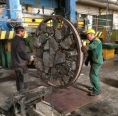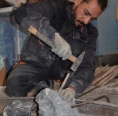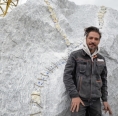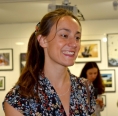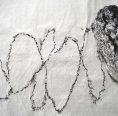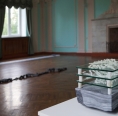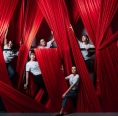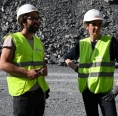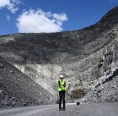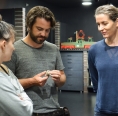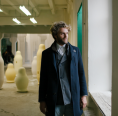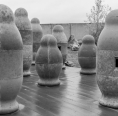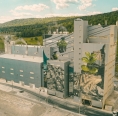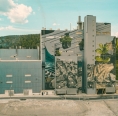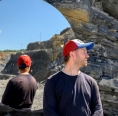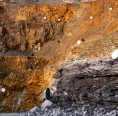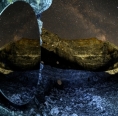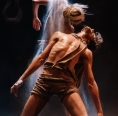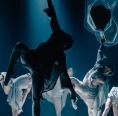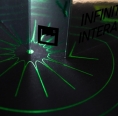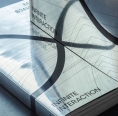-
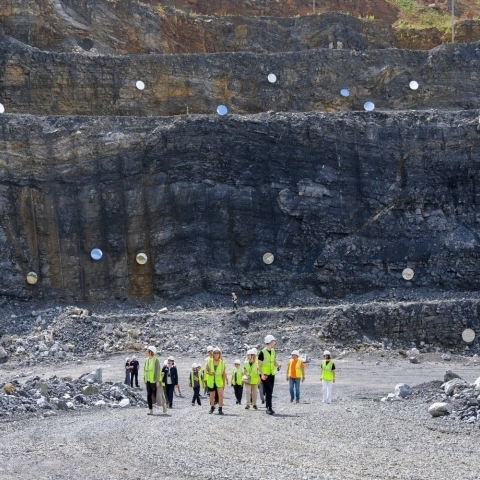
Satka
Permanent art residency of the Ural Industrial Biennial of Contemporary Art
The Ural Industrial Biennial of Contemporary Art is one of the largest regular international projects in the field of contemporary art in the Russian Federation. More than 300 artists from 52 countries took part in the Biennial.
In 2015, Satka for the first time became the art residency of the 3rd Ural Biennial of Contemporary Art. The famous Italian sculptor Jacopo Mandich chose Satka to create “Explosion” art object of metal, magnesite and dolomite, a periclase sculpture and “To the Last Stone” project presented in Yekaterinburg at the final exhibition of the Biennial.
On October 3, 2016, the Sobranie Fund and the Ural Branch of the National Center for Contemporary Art signed an agreement to establish a permanent residency of the Ural Industrial Biennial of Contemporary Art in Satka in the Chelyabinsk region.
Numerous world celebrities such as the Italian sculptor Jacopo Mandich, the Swiss artist, performer and sculptor Katja Schenker, the French artists Lea Barbazanges and Olga Kiseleva worked in Satka. In 2021, Vasily Kononov-Gredin and Andrey Olenev joined the list of artists who worked and lived in Satka.
The result of the stay and work of Lea Barbazanges in the Satka art residence of the 4th Ural Industrial Biennial of Contemporary Art was a metaphorical portrait of the city and the Karagay quarry. The city hosted an exhibition of works consisting of installations created by the artist as a result of acquaintance with the city and its texture. Jacopo Mandich presented his sculpture “To the Last Stone” as part of the Biennial. The Mandich’s stay in the city was highlighted by the arrangement of an individual workshop for the artist at the plant with technical personnel, unique plant materials and equipment provided.
In 2019, the “Infinity” performance of the Satka art residence was presented. Olga Kiseleva, an artist, head of the Faculty of Arts and Science at Sorbonne University, created a symbol of infinity striking in its scale. A kilometer-long scarlet canvas was placed in the space of the industrial landscape of the Berezovsky quarry of the Magnezit Group. The Swiss artist, performer and sculptor Katja Schenker also presented her work in the Satka art residence of the Biennial that year. The basis of her project was the “Gardens” poem by Rainer Maria Rilke. The poem describes the life and death of a tree, and this process found its metaphorical response in the work of Katja Schenker.
“The Rock Garden”, a special project of the 6th Ural Industrial Biennial of Contemporary Art, was created by the artist Vasily Konov-Gredin. The artist’s work consists of hundreds of round mirrors fixed on the benches and walls of the Berezovsky quarry with a total area of 264,000 square meters. “Recultivation” created by the artist Andrey Olenev is the largest mural in Satka (4,600 sq. m) and one of the largest murals in Russia. It covers the facade of the 14-storey high-temperature shaft furnace.
2015
This year, the Art Residence Program of the 3rd Ural Industrial Biennale of Modern Art stepped out Sverdlovsk Region. Industrial sites in Satka, Verkhnyaya Salda, Pervouralsk, Kasli, Nizhny Tagil and other towns of Ural Federal District became the new participants of the international cultural event. In each art residence, the artists and sculptures will work using the materials and technics typical for the specific production and addressing the local town and public context.
Satka was chosen by the famous Italian sculptor Jacopo Mandich. He is specialized in the work with industrial waste, primarily, iron and wood. However he is eager to experiment with other materials as well.
In Satka the sculptor works in one of Satka Production Site workshops of Magnezit Group creating three pieces of art: from magnesite, dolomite and iron. One of his works will be placed in the territory of the Group, the second one – in the town, and the third work will be presented at the final exhibition in Ekaterinburg.
The idea of town space came to the sculpture after meeting Satka people who complained about the lack of bright events and gathering places. The idea of Jacopo is to make the sculpture interactive; the townspeople will be involved in its creation.
The main program of the 3rd Ural Industrial Biennale of Modern Art will be held in Ekaterinburg from 9 September to 10 November.
To learn more about the history and the program of the 3rd Ural Industrial Biennale of Modern Art, please visit the website http://www.uralbiennale.ru
To learn more about the works of Jacopo Mandich, please visit his website http://www.jacopomandich.com/it
2015
An unusual objet d'art has appeared in Satka. On Wednesday, official and really colourful unveiling of The Explosion sculpture took place near Khitry market. It author is an Italian sculptor, Jacopo Mandich, who spent several weeks working on his creation in one of the workshops of Magnezit Group production site in Satka.
A huge sealed envelope which appeared behind Charodeyka shopping centre made the people puzzled. A lot of townsmen gathered to have a look at the wonder. Loud music and the artists rehearsing nearby tripped up the spectators even more. The children who occupied the enclosed area were lost in conjectures:
“What will be here?” “Dancing or maybe a celebration?” “Seryega, there is a letter!” “And what is inside the envelope?” Impatient questions were arising in the growing crowd of Satka children again and again.
“Look, there is a water engine. They will probably melt the envelope,” made guesses older people.
And then the show began. Accompanied by the ever-popular song of Jon Bon Jovi It’s my Life the artists of fire theatre, fire dancers, came to the makeshift stage in front of the envelope. Their graceful movements seemed to follow the infinity sign. As if accidently the envelope took fire and Satka people gradually saw the content of the mysterious package – a metal ring with blocks of magnesite and dolomite fixed inside it. Multicolour sparks were dancing around as if giving a hint to the spectators on what to expect after the official part of the event… The organizers of the project and special guests addressed the people.
Alisa Prudnikova, the commissioner of the 3rd Ural Industrial Biennale of Modern Art, director of the Ural Branch of the State Centre of Modern Art, was the first to greet Satka people:
“Satka has become one of the sites of the Art Residence Program of the Biennale. It is still unsettled whether it will be a permanent residence or not,” emphasized A. Prudnikova. “We hope you like the sculpture and this place will be attractive both for the local people and tourists. After all, the primary objective of the Ural Biennale is to make industrial towns interesting and pleasant for living.”
According to Alexey Betekhtin, the Ministry of Culture of Chelyabinsk Region, who visited the unveiling, Satka has already become not just an interesting town; it is outranging the regional centre in terms of the number of cultural events and their level.
“I have recently visited them more in Satka than in Chelyabinsk,” said A. Betekhtin. “I come here several times a year to visit interesting events which are important not only for Satka by the region in general. The present unveiling of an unusual sculpture is one of them. The Explosion, as many other pieces of modern art, can be interpreted in various ways. I think it can symbolize the meteor fall which made Chelyabinsk famous in the world.”
The unusual sculpture made mixed impressions on the spectators. The people who came to the unveiling expressed various ideas. For example, Vera Terentyeva, the head of Right to Life literature club of Satka Society of People with Disabilities, thinks that The Explosion sculpture implies an infinity wheel aimed at uniting her countrymen and boosting the townspeople for creative work.
To make everything clear, the author told about the meaning of his work with the help of the interpreter and project supervisor Evgeniya Chaika.
“It is difficult to tell a single meaning, there are numerous interpretations. I think everyone will see something own in the sculpture,” said Jacopo Mandich. “As for me, I give it two main meanings. First, it is a reminder of the moment when magnesite is taken from the mine by explosion. Second, the sculpture symbolizes the Earth crust, our planet with its continents and large expanses of water. However, the material keeps lots of secrets, and Satka people will reveal new meanings of The Explosion in the course of time. At the moment the sculpture is not finished and I hope today everyone will be able to reveal his/her creative potential taking part in painting The Explosion.”
The possibility to become co-authors of the peace of modern art became the major attraction. Buckets with red, blue and yellow paint had been specially prepared for this. At first, at the author’s request, The Explosion received red splashes symbolizing joy, fire and sun. They were made by Ministry of Culture of Chelyabinsk Region Alexey Betekhtin, Head of Satka District Aleksandr Glazkov and Jacopo Mandich himself. Then the children got into action. With enthusiastic shouting they splashed paints of various colours on the sculpture not forgetting to paint themselves and the friends as well, so some of them, painted from top to toe, seemed brighter than the Russian-Italian work.
The adults did not lag behind – lots of Satka people followed the lead of the officials. However they did it much tidier than their children and grandchildren. When they run out of paint, it was time for the selfie with the Italian sculptor against his work. Having made a photo the luckiest immediately shared it and their mood through social media with the friends who missed the party.
All Satka people and guests can see The Explosion sculpture, and every spectator can assess the work of the artist and the meanings laid by him.
Elena NIKITINA, photo of Aleksandr KRAEV
Evgeniya Chaika, the supervisor of the Art Residence Program of the Ural Industrial Biennale of Modern Art:
“I think, in a big city it would more difficult to arrange something similar and get such warm home-like effect as in Satka; there would be more formalities and restraints. The reaction here is joyful and spontaneous. This is really good! In addition, during his stay in Satka Jacopo made lots of friends and all of them came to the unveiling. There is certainly a language barrier, but as for the art, people are united not by words but visual images and the possibility to express their vision of the world through material.”
The Explosion sculpture is a metal ring symbolizing repeatability with magnesite and dolomite blocks hung inside on the metal structure forming the picture of a tectonic explosion of material. The Explosion sculpture is rarefaction and contraction, the cycle of construction and destruction calling out to the history of the used stone drawn up from the interior of Satka earth by explosive power of dynamite. A metal rocket is another element of the sculpture; it is fastened to the wall as a symbol focusing on the use of magnesite in heavy industry. The idea to paint the stones of the sculpture together with Satka people came to the sculptor after meeting townsmen who were tired of grey town space and complained about the lack of bright events and gathering places.
At the moment, another sculpture of Jacopo Mandich also made in Satka is exposed in Ekaterinburg. It is called To the Utmost Stone and symbolizes an open pit teaching careful handling of natural resources.
2016
October 3, Sobranie Fund and the Ural Subsidiary of the State Center of Modern Art have signed the agreement of establishing the Permanent Residence of the Ural Industrial Biennale of Modern Art in Satka of the Chelyabinsk Region.
The Permanent Residence of the Ural Industrial Biennale in the Chelyabinsk Region will be an ongoing center of the artistic production in the region. The purpose of work of the permanent residence is to create the successful Russian case study of revitalization of industrial areas and urban environment of industrial towns through tools of artistic production.
Satka functioning as the Permanent Residence of the Ural Industrial Biennale will facilitate to development of the arts and humanities in the city through forming the value of local urban community and establishing the stable cultural environment. Besides, the Permanent Residence will contribute to development of Satka as the destination point of the industrial tourism on the regional, federal and international levels in order to create new workplaces in the cultural / leisure field and tourism / recreation field.
In 2016, an eventful cultural programme waits for Satka residents and guests. Plans for November include Poetry of the Worker Beat performance concerts, as well as educational programmes and master classes for children and adults. In December, it is planned to present the performance of Provincial Dancing Theatre of Modern Dance and photo laboratory, Satka: Four seasons.
2016
Let us remind you that in October 2016, Sobranie Fund and the Ural Subsidiary of the State Center of Modern Art have signed the agreement of establishing the Permanent Residence of the Ural Industrial Biennale of Modern Art in Satka of the Chelyabinsk Region. The residence will be an ongoing center of the artistic production in the region.
First events offered by Satka residence start already October 31. During three days, the Center of Cultural Initiatives will host master classes and lectures "Holidays with Modern Art: Laboratory for Children and Adults". During the classes held in the laboratory under supervision of artist and coordinator Vladimir Selesnyov the participants will create their own artistic work that would combine modern art techniques and usability. Participants will take the resulting work home.
November 3, Poetry of the Worker Beat performance concerts will take place in Magnezit Cultural Center. According to the event providers, this a collage performance, mosaic performance gathered from music, video and unique poetry of factory workers: “Right in front of spectators, all components of the performance fall apart and fuse into a powerful dynamic visual imagery. Rhythmically harsh, straight-from-the-shoulder poems of the worker beat praise the industrial theme of the first five-year plans that give rise to main imagery of the performance – a vivified factory giant, a human machine. This is the worker masses poetry, in which details are mixed with bold metaphors and motives bordering with science fiction”. One of the main components of the performance is music specially composed by famous electronic music gurus, 4 Positions of Bruno. Declamation will be performed by Anton Makushin, actor of Kolyada Theatre (Yekaterinburg). The performance starts at 5.00 p.m. and 7.00 p.m.
2016
Actors of the Provincial Dancing, Yekaterinburg Theatre of Modern Choreography will present a play based on The Woman in the Dunes, Kobo Abe novel.
According to the idea of the author and director, Tatyana Baganova, Sepia is not retelling the story told in the novel, but an attempt to deliver moments of state of a person in certain conditions. “The main idea to consider sand as negation of stability is not that insane, movement of one eighth of millimeter, the world, where existence is a sequence of states… May be, it is absence of the form that is the highest manifestation of power.” This and other remarks of the novel author can be seen as the key to understanding the play.
Sand in Sepia is at the same time habitat for the heroes, symbol of time and an external factor that transforms consciousness. It streams from the hang glass bulbs down on dancing men and women, fills the scene turning it into the picturesque painting. It dictates rhythm, atmosphere, choreographic and image-bearing solution of the performance, it becomes its main dramatis personae and the habitat of characters.
In the ensemble dances, actors resemble either wild animals, or mysterious insects, which the novel hero set out in search of. Invincible power of vitality, a special sense of time are read in this full tension that the performance delivers.
Endless pouring out sand is emphasized with long, lingering sounds of the Eighth Symphony of Awet Terteryan, in which the composer revealed the image of the primeval spirit of being that magically affects thoughts and feelings of spectators.
Sepia performance was created by Tatyana Baganova in the USA pursuant to the order of the American Dance Festival under International Choreographers programme. In autumn 2011, the Russian premiere of the performance took place. In 2012, Sepia became an awardee of Bravo! prize as the Best Musical Performance. In 2013, the performance received four nominations by Gold Mask Russian National Theatre Award.
The performance will take place in Magnezit Cultural Center December 14, 6 p.m. After the end of the performance, meeting with the theatre company is planned. Admission free.
2017
Magnezit Group became a partner of children’s programme of the Ural Industrial Biennale.
New programme of the Workshop No. 9¾ 4th Ural Industrial Biennale starts on September 16 and will work every weekend in the Ural Branch of the State Center of Modern Art (SCMA) (Yekaterinburg). This site is for 5 to 12-age researchers and experimenters.
Specialists of the Magnezit Museum and the Scientific City Children’s Science Center prepared popular science classes, games, contests and creative assignments for children.
Thus, on September 17, specially for participation in Workshop No. 9¾ children’s programme, Magnezit specialists will bring unique interactive exhibits of the museum, tell about open-cast and underground mining methods of magnesite mining technologies, and acquaint with rock samples. Younger children will see cartoon film Our Assistant Magnesite and will make applications with the Magnik. Children between 8 and 12 years of age will watch a video about magnesite mining technology, get acquainted with mobile interactive production process scheme, play Chronologics, and try on clothes of Magnezit employees of various professions.
Details about the animated film Our Assistant Magnezit may be found here.
2017
In Magnezit Cultural Center an exhibition of the French artist Lea Barbanzange " Trace of Stone" was opened.
Several works shown at the exhibition were created by the artist with the assistance of Magnezit employees in Satka. Among them, a metaphorical portrait of the city and Karagaisky open pit, which the artist applied to volcanic stone, a rock hardened with fire and therefore fire-proof, like magnesite.
Among exhibited items, you can also see a scroll of Japanese paper on which a trace of a rolling stone is printed. The work was created by frottage technique and was the first to be made by Lea in Satka. There is an installation, which is pieces of dolomite, laid out in a line and connected by a thin line of magnesite. And the most complex work finishes the exposition. Lower layers are magnesite with flecked dolomite, then the volume is filled with air and layers become more transparent. Contours of Karagaisky open pit are lined with mosaic from fused periclase on the glass.
You can see all this with your own eyes. The exhibition will continue until August 11. Free admission
2018
TWO SPIRITS. 2017
Everything comes from the earth and returns to the earth. Everything has an infinite number of faces and transformations. A person herself creates a shell to keep the innermost in it. However, more often the society does it for her.
Florian Graf offers a kind of constructor, in which an average form resembles the matryoshka doll. However, this is a deception. Matryoshka dolls dancing with a given rhythm jump into each other as if boasting of their similarity and emptiness. Here, all figures are very similar, but none of them can devour the other, none of them lacks individuality. As a container, each figure carries its uniqueness inside.
If you change the scale slightly and look at all the sculptures at once, you will see a structure. Their anthropomorphic shapes accorded with a grid become a metaphor of a society, where everyone is alike and unique simultaneously, their facelessness depriving them of human resemblance. And now there is an army of chess figures marching towards us, or then the entire picture appears to be a bowling track in the middle of a game, or a Japanese garden with lanterns, or flowerbeds…
As we walk about these unnamed objects, we stumble upon the riddles of life, here and there: perhaps, there is a pot on a window shelf, and a flower grows in it, and one hears how the wind makes the fire of a candle dabble and quiver; perhaps, beneath the closed windows a new life comes to being or someone grieves silently, unable and unwilling to cast a glance upon the urn, which keeps the ashes of the beloved one.
The simpler the form, the more complex its combinations: fire of life and ashes of death, willingness of the female and aspiration of the male, convenience of the general and inescapability of the individual, limitedness of the silhouette and infinity of the face, rapidity of growth and slowness of changes. Thus, one wrong glance is enough to recognize the future golem in an innocent child.
Text from the catalogue of the 4th Ural Industrial Biennial of Contemporary Art “New Literacy”.
2019
The 5th Ural Industrial Biennale of Contemporary Art will take place in the period from 12 September to 1 December in Ekaterinburg and other Ural cities.
Biennale is the biggest regional project that views industriality as heritage and current practice of Russian regions, displays and explains Russian industrial development using contemporary art language.
Biennale hosts the Art Residence Program that establishes cooperation with the existing Ural plants and opens an opportunity for artists to create projects being in direct contact with plant environment and integrate art in Ural industry. The final outcome of artists staying in a residence is the creation of art-specific works in the context of a host city/plant. In addition to that, the results of the Art Residence program will be presented at the final exhibition that is expected to open together with the main project in Ural Optics and Mechanic Plant, the core location of the 5th biennale.
Since 2016, Satka has been the Permanent Residence of Ural Industrial Biennale in Chelyabinsk Region. It is ready to host the new participant of the Art Residence Program for the fourth time now. This year the industrial city center will be visited by Katja Schenker, Swiss artist, performer and sculptor.
Katja Schenker was born in 1968 in St.Gallen, Switzerland. She now lives and works in Zurich. Before gaining master’s degree in Zurich Art University, she studied literature, art history and philosophy in Zurich University and High School for Advanced Social Studies in Paris.
Katja Schenker’s works comprise both performance and culture. She uses paintings, photos and videos to deepen and document the consecutive stages of her artistic process. The choreography of her performances is made with movements that transform materials or objects.
“Katja’s projects always imply physical presence and perception of the environment by the author. In the context of biennale, the idea of working both with materials and the unique local history seems to be promising”, reads the webpage of Swiss-based Pro Helvetia Board which is a permanent partner of Ural biennale and Sobranie Foundation.
Swiss stage manager Severin Kun and coordinator of Art Residence Program Kristina Gorlanova came to Satka together with Katja. Severin Kun makes documentaries about artists and scientists. At the moment he is busy with the film about Katja Schenker.
The guests have already visited many pits in Chelyabinsk Region, including Korkinsky coal mine, Balandinsky marble quarry and Taiginksy graphite mine, but they decided to stay in Satka. “We suggested that Katja should visit Satka, because we have had art residences here several times. We are very glad that Magnesite Group, Sobranie Foundation and Satka support biennale, and our artists are happy with the opportunity to work here too. Katja was impressed greatly with local fireproof materials and, of course, with the size of the pit. That’s why we came here. Our target was to develop a project for the 5th industrial biennale”, said Kristina upon her arrival to Satka.
A poetic link was used by the sculptor as the basis of the project. Inspiration was drawn by her from the Gardens poem by Rainer Maria Rilke. It tells about the life and death of a tree. “It is an existential metaphor, which becomes even more obvious in connection with immortality as the main idea of the 5th industrial biennale. Moreover, it is very close to industrial processes with a wavelike history: a field deposit starts to be developed and turns into a mine pit, but then it returns back to nature, as, for instance, in case with Balandisnky pits which are now a place for open-air recreation. Katja says among other things that this is a big circle”, continues Kristina Gorlanova.
The main idea of Katja’s project is to make an imprint of Karagaisky pit on a long sheet of paper. “Finally, we’ll have a huge sculptural project partially showing the contours of the mine pit with human presence in the landscape. It will be a new landscape model giving the precise picture of what Katja saw and how she felt in the mine pit”, comments the coordinator.
Ural-based industrial biennale is the biggest international art project on the territory of Russian Federation. Founded by Ural branch of the National Center for Contemporary Arts and Russian Culture Ministry, it deals with local specifics and each time finds new facets of industriality. In the period from 2010 to 2017, it involved 319 foreign artists from more than 45 countries worldwide. The project was supported by 48 foreign partners. Biennale is closely connected with Ural industrial culture and views industriality as an era, cultural phenomena and current practice that covers a great many of people and spaces.
The main idea of the 5th biennale is immortality, which gives good reasons to think about things that will stay after the production and artistic processes are over. Will it be a product or any other results?
The Art Residence Program is one of the strategic programs within the scope of Ural Industrial Biennale. It first took place during the 2nd biennale in 2012. Since then, it has seen over 20 artists from 9 countries and more than 30 new art objects.
The program is focused on cooperation between people working in various areas of visual art and the existing factories. This is a fundamental difference of Ural art residences from many other similar places across the globe. Artists are able to dive into local specifics, myths and lifestyle pattern, which is a good way for them to study Ural industrial heritage and production processes of the existing plants.
Starting from 2015, Italian sculptor Jacopo Mandich, French artist Lea Barbazanges and Swiss artist Florian Graf have studied production and industrialization processes through culture.
2019
"Infinity" performance is a new project of Satka residence of the 5th Ural Industrial Biennale of Contamporary Art that was implemented with support of Sobranie Fund.
Together with Magnezit employees, Olga Kiselyova, the author of the project, an artist, head of the Art And Science Department of Sorbonne University (Paris) created a huge symbol of infinity in the Beryozovsky quarry of Magnezit Group.
Her idea is in rethinking the industrial heritage and translate it into another dimension. “This is a dimension of infinity of the nature we protect from adverse effect of industrial hazards. At the same time, the industrial heritage is also a cultural phenomenon. We deliver the industrial aesthetics to the forefront, show its beauty, – Olga says. – I was impressed by forms of Magnezit quarries, by beauty of the relief and colors. And some roads here also show the infinity sign. While red is my favorite color. Besides, in Russian “red” and "beautiful” are synonyms. That’s why, when we want to do something significant, we often use the red color".
2019
The "Infinity" performance can be seen in Satka, Magnezit Cultural Centre. It was created by Olga Kiselyova, who is an artist, professor at Sorbonne University and director of the International Institute of Art and Science, and worked in the Satka art residence of Sobranie Fund.
The idea of the performance originated in the Louvre Museum in Lens (a mining town-factory in Northern France), where Olga Kiselyova was invited to take part in an exhibition dedicated to the opening of the Museum. The new ultramodern museum building consisting of several modules, seems to be an ideogram encrypted into the landscape. When seen from up above, the architectural ensemble looks like the mathematical infinity symbol. The performance represented a public reproduction of the infinity symbol in the museum gardens and emphasized the role of the art institution that preserves art, helping it to overcome time and gain immortality, to infinity.
In Satka, the performance was brought to realization in the space of the industrial landscape of the Berezovsky quarry of Magnezit Group, which redefined the meaning of the event. It has made the infinity and immortality of the industrial production culture visible, this modern way to connect with the immortality of natural materiality.
The project was delivered as part of the 5th Ural Industrial Biennale of Contemporary Art, and supported by the National Centre for Contemporary Art.
The perfomance will run until December 10.
2020
The catalog of "Immortality", the 5th Ural Industrial Biennale, will be presented in the Art Lecture Hall of Gorky Park on September 12 in Moscow. The catalog was published with the support of Magnezit Group.
At the first Russian Creativity Week, the Biennale team will present the Ural and Ural Industrial Biennale to the general public. Commissioner of the Ural Industrial Biennale Alisa Prudnikova will sum up the results of the project and introduce the Ural art. Dmitry Bezuglov, the Curator of the Public Program, will explain how we now feel about the Immortality. Elizaveta Yuzhakova, the Catalog Editor, will share how not to sleep for many days to put a huge exhibition in one book. Natalia Nikiforova, the Director of Corporate Development and Strategic Communications Department of Magnezit Group, will explain why the cultural project should be supported and why the cover of the catalog depicts the “Infinity”.
Read more: https://creativityweek.ru/event/1149
2021
Ural Industrial Biennial starts a program of routes to art-residence’s towns in July: Satka, Kyshtym, Chernoistochinsk. Each of the routes is a trip to the towns of the Urals, a visit to existing and abandoned plants and also an opportunity to see the first art works of the 6th Biennial.
More details about the starting in July routes:
2 days route “Yekaterinburg – Satka – Kyshtym – Yekaterinburg”.
On this route you can see open cuts of Satka's Magnezit Plant, one of the oldest hydro power plants in Russia and the only remaining palace building of the South Urals. The route is remarkable for 3 bright projects to be demonstrated in 2 days:
- a mural by Andrey Olenev, a street artist from Nizhny Novgorod, on the facade of the 14-storied high-temperature shaft furnace;
- a special project by Vasiliy Kononov-Gredin. Hundreds of circular mirrors on the territory of the huge Berezovsky quarry;
- a sculpture by Ivan Gorshkov in the bed of the Krystymka river.
See more about tickets and details:
July 17–18:
https://uralbiennial.timepad.ru/event/1689044/
July 31 – August 1
https://uralbiennial.timepad.ru/event/1689044/
1 day route “Yekaterinburg – Kyshtym – Yekaterinburg”.
This route includes a visit to a machinery manufacturing plant usually closed to tourists and a tour guide of the historical center of the town.
If you go to Kyshtym on July 18, you can visit a lecture by Anastasia Sosnovskaya, a popularizer of art and author of the channel @art.likbez. Anastasia will talk about the art as a system of symbols and plots, the decryption of which may lead to an answer to a question that has been haunting many people “What did the author want to say?” You can try this decryption method on a trip by studying a new sculpture by Ivan Gorshkov in the bed of the Krystymka river.
See more about tickets and details:
July 18
https://uralbiennial.timepad.ru/event/1702342/
July 24
https://uralbiennial.timepad.ru/event/1689380/
1 day route “Yekaterinburg – Chernoistochinsk – Yekaterinburg”.
This trip is guaranteed to become a complete immersion in the hearth of Ural industry, all interested can visit the 2 oldest Ural factories of the Demidov Empire and then see the exhibition of Vadim Kondakov, where he will present the original abstract graphics created by the interaction of water, metal and fabric.
See more about tickets and details:
July 25
2021
The installation was made in the Berezovsky quarry of the city of Satka. Magnesite had been extracted in the quarry for the production of refractory materials since 1980, and the mineral extraction was stopped at the end of 2020. The pumps pumping water from the bottom of the quarry were also turned off, and now it is slowly filling with water. After some time, there will be no traces of production and only a large turquoise lake will remind visitors that there was once a mineral extraction site.
The installation includes 250 mirrors fixed on the benches and walls. The mirrors are configured to reflect sunlight on the quarry walls in shade and on the water. The artificiality of the landscape, its contemplation through mirrors and refracted light creates a space similar to the Japanese garden of stones. Many mirrors are mounted in the shadows of the benches, behind the stones, and reflect the quarry itself on those sides that were invisible to the viewer. The installation helps the viewer to interact with those places of the quarry that used to be hidden and change the usual points of view on its landscape.
The quarry is perceived in a new way through the mirrors and reflections. But it is obvious that a new form of perception of the artificial landscape is impossible without the presence and contemplation of a human being. The universe is reflected in a person, and we see how the human world is reflected in the quarry through the mirror installation. Over time, the quarry will be flooded and will go underwater together with the installation, so the audience witnesses the disappearance of the artwork at the time of its creation. The gradual flooding of the quarry will take more and more mirrors away from the viewers. In the end, it will be impossible to see the reflection, there will be no observers and hence no contemplation.
The size of one mirror is 125 cm, the size of the entire installation is 240,000 sq.m.
The work is a part of the 6th Ural Industrial Biennale of Contemporary Art.
2021
The artist Andrey Olenev has finished extensive work mural "Recultivation" on the buildings of high-temperature shaft furnace of Magnezit Group.
Andrey Olenev lives in Nizhny Novgorod, a city known for its unique street art. Olenev was one of those who formed the special language of street art in Nizhny Novgorod in the 2010s. It is his advanced technique that makes him stand out among other street artists. He thinks his compositions through down to the smallest detail, uses layering, prefers a restrained color scheme, and is passionate about allegorical subjects; therefore, his art might remind us of classical paintings. In his work, the artist focuses the city and the environment. Olenev pays close attention to the history of the place where he creates his murals.
While staying in Satka, the artist visited quarries, production workshop and talked to the employees of the Magnezit plant. As a result, he created a collective image of an employee.
The 4600-square-meter painting titled Recultivation is located in the facade of the building of department for the production of powders. The mural depicts the hands that protect a scion. We cannot see to whom the hands belong. Olenev often uses this artistic device in his works. Thus, the artist conveys the idea of collective responsibility.
The mural refers to the thoughts and experiences of Satka residents and to Soviet monumental painting. The latter is an anthem to the new world construction and a worker who can do everything. But in the modern context, Olenev sees labor as each plant worker taking care of the environment and their homes on a daily basis.
Andrey Olenev (b. 1993, lives and works in Nizhny Novgorod) is an artist, a member of the informal art association Muddlehood and a co-founder of TOLK Gallery, which has supported Nizhny Novgorod street artists since 2014. He works in various techniques (painting, pyrography, object, installation and artist's books). He is famous for his monumental murals on the facades of old houses in Nizhny Novgorod's historical center and for his multicomponent wooden objects that completely or partially disguise the painted images and provide tactile interaction. Andrey Olenev took part in the research project of the 5th Ural Industrial Biennial of Contemporary Art. He has also participated ingroup and solo exhibitions, festivals and street art projects in Nizhny Novgorod, Moscow, Perm and other cities around Russia.
2021
The day of metallurgy was marked by new openings and records: Satka production site of Magnezit Group has become a part of a big program of the 6th Urals Industrial Biennial of Contemporary Art. The grant opening of mural “Reclamation” on the buildings of high-temperature shaft furnace and mirror installation “The rock garden” in Berezovsky quarry was held within the first Biennial route to art-residence’s towns on July 17.
Participants in the route to art-residence in Satka were managers, curators and program coordinators and also guides of the Ural Industrial Biennial of Contemporary Art. The guests made an extraordinary journey: in one day it was possible to visit not only the museum and Magnezit Cultural Center, the exhibition “Rock Samples”, Art-Satka, to admire street art and other sights of the town, but also to visit an active plant and to witness unique events.
ART RECORD ON “RECORD”
The acquaintance of the guests with the Magnezit Group began with sociocultural projects supported by the company in the city and then directly in the plant. Impressed by the scale and beauty of the industrial panorama opened from the viewing platform “Russky Magnezit” guests became acquainted with the unique manufacture of the complex of melted powders “Avangard”. Needless to say about emotions. Literally, every step of the way accompanied by excitement were photographed and videotaped. The peak of admiration was on “exclusive”, the moment of break-up of the periclase block with a breaker boy, as well as the opportunity to photograph with the first received here periclases (block with a talking inscription “Congratulations!” did not need comments) and to hold the finished product in hands. “It’s an incredible miracle! Oh, my God, it’s diamonds! It’s brilliant! It’s amazing!”, a stream of epithets and cues that seemed unstoppable.
One of the main events of the day before holiday took place on the viewing platform of the complex of tight sintered powders “Record”. By embodying industrial achievements and records, it also became an art record holder. Mural created by the artist Andrey Olenev on the buildings of the shaft furnace is the largest in Satka (4,600 square m) and one of the largest in Russia. It is also the first work that was inaugurated in the presence of Magnezit workers and guests of the Satka Art-residence.
"The Biennial routes to art-residence’s towns that we are launching this year take place before the official opening of the Biennial (this year it will take place on October 2). As you can recall, the theme of the 6th Biennial is “Time to Embrace and Time to Refrain from Embracing” and today the whole day feels the embrace of the beautiful town of Satka, the hug of the factory. For more than 10 years, the Urals Industrial Biennial has been experimenting with different scenarios of the interaction of art and production, and we see in it a huge energy, an incredible number of possibilities to connect this amazing, giant scale of industrial production and unique artistic optics", noted Alice Prudnikova, Biennial commissar.
During the work in the residence Andrey visited quarries, production subdivisions, interacted with the Magnezit Group workers and created a collective image of the worker in the painting. Plot center of mural is the hands that protect the plant shoots. The viewer does not see the human face because the character does not fit in the painting frame. Olenev always uses this technique in his works. Character impersonality says that responsibility for the plant does not lie with a specific individual. It is common.
"It’s very exciting to open our first art object created in the art-residence. I am glad that it happened in Satka because exactly this town, Magnezit Group and the Sobranie Fund are partners with whom the Biennial cooperates for many years", said Vladimir Seleznev, manager of the Ural Industrial Biennial Art-Residence at the opening of the mural. "Andrei has created the mural on ecological theme, since we have learned and have seen what modernization goes on Magnezit how the enterprise relates to ecology. There is a program “Million trees”, and it is, precisely, a big responsibility of the enterprise to the town, to nature. In addition to that, there are pieces of magnesite with warm windows cut into them, which is the warmth of the shaft furnaces, the warmth of your work, the warmth that you share with the town".
On this “warm note” linking Magnezit and the town, art and labor, artist and spectator, the managers of the Biennial noted the importance of creating works of art on active plants, which contributes to the fact that “employees of enterprises increasingly become adepts not only of their profession, but also of contemporary art”.
MIRROR EFFECT
On the same day, the presentation of the large-scale mirror exposition in the Berezovsky quarry “The Rock Garden” took place. This is a special project of the 6th Ural Industrial Biennial of Contemporary Art created by painter Vasiliy Konov-Gredin.
"This is the largest work ever created at the Biennial", noted Alice Prudnikova. "We dreamed about creating something exactly in this quarry and are happy that by the 120th anniversary of Magnezit everything has come together, and Vasily has created such an amazing project!"
The project is surprising from the first steps. “Do you see the two mirrors in front of you?”, Vasily started the excursion with question. Despite attempts by the audience to see the second mirror, they saw it only with a hint from the author. A huge circular surface (the diameter of each mirror is 120 cm) literally dissolved, as it reflected almost the same relief and soil in which it was installed. And as the viewer moved through the installation, he made more and more discoveries and got more and more incredible experiences: a waterfall surrounded by mirrors, the sound of falling water and the movement of constantly changing reflections, majestic stone ledges, the result of long years of mining and a gradually growing lake at the bottom of the quarry. And also, the effects that give light, color, shades, “game” and mood of the whole environment and nature itself... It must be seen!
You can visit the art objects joining the routes of the 6th Ural Industrial Biennial of Contemporary Art (https://uralbiennial.ru/) or contact the Magnezit Museum: +7 (35161) 9-46-84.
FOR REFERENCE:
The Urals Industrial Biennial of Contemporary Art is one of the largest international projects in the field of contemporary art in the regions of the Russian Federation. More than 300 artists from 52 countries participated in the event.
Permanent residential quarters of the Ural Industrial Biennial of Contemporary Art works in Satka for more than five years. And it is not for the first time that Magnezit becomes a place where the biennial participants express their ideas. This time, industry and art are united by industrial architecture. This year’s Art-Residences program takes place in Asbest, Nizhny Tagil, Polevskoy, Sysert and Chernoistochinsk in the Sverdlovsk Oblast, Kyshtym, Satka, Chelyabinsk and Sokol in the Chelyabinsk Oblast.
2021
The awards ceremony for the winners of the First National Awards, the Russian Creative Awards, in the field of creative industries took place in Moscow.
We congratulate the winners and thank the experts for the high appreciation of our work, we are honored and happy to pass such a high competitive selection (there were more than 3000 applications from 72 regions of Russia!) and to be presented in the top-5 candidates for victory in two nominations of the Awards at once.
Sobranie Fund became a finalist at the Awards in the nomination “Maecenas” in the field of CI (a company or a person, who made the most significant contribution to the development of creative industries) with the Art-Satka project of public creative space. With the Stone Garden project in the Beryozovsky quarry of Magnezit Group within the art residence of the 6th Urals Biennale of Contemporary Art – in the nomination “The Best Creative Project of Industrial Sector”. This is a great victory for us, a recognition of the importance, necessity and success of our projects, not only in the field of creative industries, but in the life of everyone for whom we work. In the life of small, beloved and amazing Satka, its residents, our many friends and partners. And we are grateful to all for very kind and warm words that we received both during the awards ceremony and afterwards. We were glad to meet our friends and make new acquaintances. The Awards were not just a competition: its final was a celebration for us. It was an incredible emotion, inspiration and a source of energy for new ideas and new achievements!
-
2025
Lecture series on art
-
2012
The Russian Museum. Satka
-
2019
MAMM

